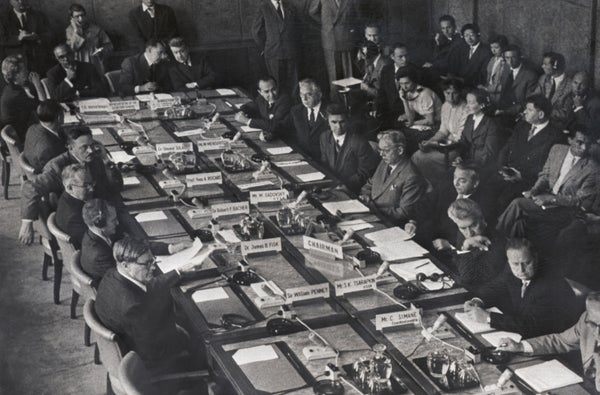November 7, 2024
4 min read
We Need Scientific Brainstorming about Shared Global Dangers
It is difficult to disentangle Russian and Chinese scientists from international science cooperation. That is a good thing

In 1958, Soviet and Western scientists met in Geneva to discuss how to monitor a proposed ban on nuclear testing.
With Russia and the West adversaries again, their scientific cooperation has been drastically cut back. And as tensions also build between the U.S. and China, the U.S. has agreed to only short-term extensions of the two countries’ 1979 Agreement on Cooperation in Science and Technology and is likely to trim its coverage in the longer term.
International scientific organizations are also under stress. For example, CERN, the European laboratory for particle physics near Geneva, was created after World War II to help bind Europe by bringing together physicists from countries that were formerly adversaries to build and conduct experiments with the world’s most powerful proton accelerator. But CERN recently announced that it will cut ties with Russia’s government because of its continuing war on Ukraine. Russian scientists currently working at CERN will be allowed to stay only if they change their affiliations to institutions outside Russia.
CERN is attempting to distinguish between Russia’s current government and Russia’s scientists, many of whom support the internationalism that nuclear physicist and dissident Andrei Sakharov promoted in his remarkable 1968 essay “Reflections on Progress, Peaceful Coexistence, and Intellectual Freedom.”
On supporting science journalism
If you’re enjoying this article, consider supporting our award-winning journalism by subscribing. By purchasing a subscription you are helping to ensure the future of impactful stories about the discoveries and ideas shaping our world today.
Another international organization, ITER, is building an experimental fusion reactor in southern France. Unlike CERN, however, ITER has no plans to cut its ties with Russia’s government. The basic design for the reactor was proposed by Sakharov and physicist Igor Tamm in 1951; the international project was proposed by the late Mikhail Gorbachev, then general secretary of the Soviet Union, at the suggestion of one of his physicist advisers. And Russia is providing key components for the power supply and for protection of ITER’s superconducting magnets.
It is difficult to disentangle international science. That is a good thing. International scientific cooperation is key to dealing with global problems such as nuclear weapons, pandemics, climate warming and misuses of artificial intelligence. It also creates opportunities for scientists to brainstorm about how we can deal with those problems. Governments have long recognized this. The Intergovernmental Panel on Climate Change is only one of the international organizations founded to facilitate agreement on the scope of various global problems and analyze possible mitigation strategies.
During the cold war, the Pugwash Conferences on Science and World Affairs, an international organization of scientists that was created in response to the 1955 Russell-Einstein manifesto against nuclear weapons, brainstormed ideas that facilitated nuclear arms control, bans on chemical and biological weapons and deep cuts in the massive military confrontation along the border between what was then East and West Germany.
In the 1980s I was among the U.S. scientists who brainstormed with Gorbachev’s physicist advisers on steps to end the nuclear arms race, starting with the underground testing of new nuclear warhead designs. Evgeny Velikhov and Roald Sagdeev, two of Gorbachev’s advisers, were fusion scientists who had collaborated with foreign counterparts for decades. Indeed, on my first visit to the Soviet Union, when the ebullient Velikhov welcomed me at Sheremetyevo International Airport near Moscow, he was wearing a Princeton University tie from one of his many visits to the Princeton Plasma Physics Laboratory.
A decade later, when I worked in the White House Office of Science and Technology Policy, the legacy of openness fostered by Gorbachev was so strong that then president of Russia Boris Yeltsin allowed experts from the U.S. nuclear weapons laboratories to cooperate with experts from Russia’s nuclear laboratories to increase the security of the country’s huge stocks of nuclear materials and warheads.
Chinese nuclear weapons physicists were also inspired to join in the international brainstorming. Starting in 1988, under the auspices of the International School on Disarmament and Research on Conflicts, the Italian Pugwash group, they organized a biennial seminar in Beijing (now called the PIIC Beijing Seminar on International Security) with European and U.S physicists. These physical meetings have ended under China’s president Xi Jinping, but brainstorming continues by Zoom.
Between the two world wars, Niels Bohr, Albert Einstein and other leading members of the physics community engaged in the cooperative international effort to develop modern physics. Bohr never lost faith that the path to salvation for human civilization lies through an “open world.” He made repeated efforts to persuade world leaders and finally, in 1950, wrote in his Open Letter to the United Nations, “Every initiative from any side towards the removal of obstacles for free mutual information and intercourse would be of the greatest importance in breaking the present deadlock [the cold war] and encouraging others to take steps in the same direction.”
Gorbachev embraced what he called the “new thinking” and used “glasnost” (“openness”) to open the Soviet Union internally and to the world. This enabled him to work with U.S. presidents Ronald Reagan and George H. W. Bush to end the cold war and start a process that slashed the combined Soviet/Russian and U.S. nuclear arsenals by almost a factor of 10.
The authoritarian regimes that Russian president Vladimir Putin and President Xi have built make international cooperation more difficult, but the West needs to consider the costs and benefits of proposals to build additional walls. We do have secrets that must be protected, but unnecessary barriers will weaken us at least as much as our adversaries—especially where they make it more difficult for scientists to share ideas about how to make the world more safe and livable.
This is an opinion and analysis article, and the views expressed by the author are not necessarily those of Scientific American.







